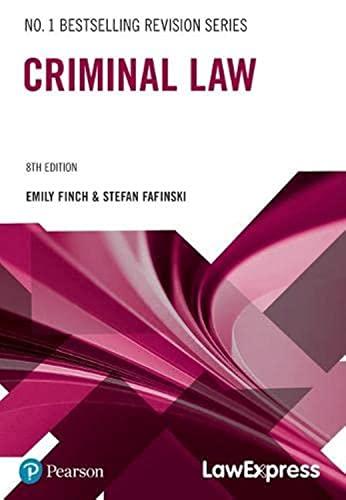Question
Criminal Law Case Study Analysis On a cool, dark evening, Bruce Wayne strolls through an unfamiliar neighborhood. The neighborhood is located in an up-and-coming part
Criminal Law Case Study Analysis On a cool, dark evening, Bruce Wayne strolls through an unfamiliar neighborhood. The neighborhood is located in an up-and-coming part of the city, and it is dominated by once- commercial buildings that have been turned into residential lofts. Bruce looks at a clock tower in the distance and notices the time, which is midnight. Bruce decides that he needs a place to warm up before it gets any colder, so he begins looking for a building where he can spend the night. Based on their dimly lit facades, all the buildings around Bruce appear to be commercial buildings. In fact, they are all residential dwellings. To get some sleep, Bruce breaks into a covered parking lot attached to a particular residential building that Bruce genuinely believes is a commercial building. After entering the parking lot, Bruce notices a briefcase sitting next to a car. He briefly contemplates what he should do, and then he decides to steal the briefcase. After Bruce takes the briefcase, security guards spot him from a hidden security camera located in the parking lot. The guards detain Bruce and eventually turn him over to state law enforcement authorities. Bruce is charged with burglary. In this jurisdiction, burglary is defined as "recklessly breaking and entering into the dwelling of another at nighttime with the intent to commit a felony therein." The jurisdiction has adopted the Model Penal Code definitions for mens rea. Mens rea is defined as a "guilty intent". Larceny is a felony in this jurisdiction, and is defined as "taking and carrying away the property of another with the purpose to deprive the owner of the property." Trespass is a misdemeanor in this jurisdiction, and is defined as "knowingly entering or remaining on another's property without the owner's consent." The necessity defense is defined as follows in this state: "necessity is a defense that permits a person to act in a criminal manner when an emergency situation, not of the person's own creation compels the person to act in a criminal manner to avoid greater harm from occurring."
- Examine statutes to determine relevant law and established rulings (BL4)
- Analyze statutes for probable outcomes (BL4)
- Apply abilities to read and understand statutes to case study analysis (BL3)
- Discuss the differences between actus reus and mens rea and how they are relevant to the prosecution's case (BL2)
- Identify the most common defenses asserted in criminal cases (BL2)
- Apply the IRAC format to a written analysis involving court opinions (BL3)
- Develop an internal law office memo (BL3)
Please read the attached hypothetical and compose a well-organized law office memo using IRAC analysis in answering the following questions:
8 Is Bruce liable for burglary?
9. Can Bruce be charged with any other crime?
10. Does Bruce have any defenses?
Step by Step Solution
There are 3 Steps involved in it
Step: 1

Get Instant Access to Expert-Tailored Solutions
See step-by-step solutions with expert insights and AI powered tools for academic success
Step: 2

Step: 3

Ace Your Homework with AI
Get the answers you need in no time with our AI-driven, step-by-step assistance
Get Started


